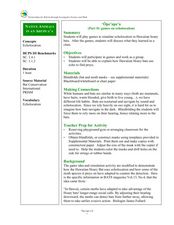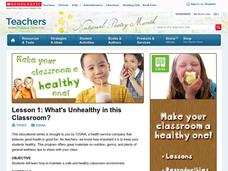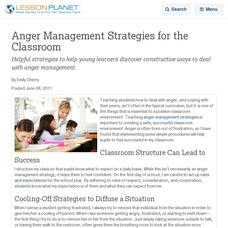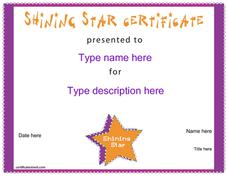King Country
Lesson 2: Private & Public
What is the difference between a private and a public place? The focus in this second lesson on family life and sexual health is building an understanding of the difference between the concepts of private and public and the behaviors...
Curated OER
Games on Echolocation
Get a little batty with life science! This fun simulation game replicates how bats use echolocation to hunt moths in their native Hawaiian habitat. After creating blind folds and discussing some basic principles of echolocation, students...
Baylor College
What Makes Water Special?
Get close up and personal with a drop of water to discover how the polarity of its molecules affect its behavior. Elementary hydrologists split and combine water droplets, and also compare them to drops of oil. Much neater than placing a...
Curated OER
Angry Feelings (Responsible Personal Conduct)
Students review proper classroom behavior and anger management techniques.
Curated OER
Responsibility in the Classroom
Students study responsible behavior. In this behavior lesson, students discuss ways friends show responsibility. Students take turns selecting a card about responsible behavior and describe the card's behavior. Students make a list of...
Curated OER
Lesson 1: What's Unhealthy in this Classroom?
Students discover behaviors and practices that are unhealthy within their classroom environment. In this early childhood lesson plan, students identify behaviors and practices that lead to an unhealthy environment, and discuss how to...
Curated OER
Positive Behaviors of Strong Marriage Relationships
Students brainstorm a list of the characteristics they believe make a strong marriage. As a class, they are introduced to the actual characteristics and they compare them with their list. After watching a PowerPoint, they discuss the...
Curated OER
Creating a Classroom Belief Statement
Fourth graders cooperatively develop a classroom belief statement that serves as their classroom constitution. Each student is involved in the creation of the statement. Each group presents their belief statement to the class.
Curated OER
The Rules of the Game
Students debate whether college athletes should be held to a higher behavioral standard than non-athletes. Students determine whether behavior outside of school should be punishable by university administration, then write letters to the...
Curated OER
Psyching up the Stock Market: Using the Harkness Method to Explain Behavioral Economics
Students can discuss the stock market and economics by using the Harkness method.
Curated OER
Wonderful World of Dinosaurs
Second graders obtain information about the characteristics of diet, locomotion, behavior, habitat, and anatomy of five dinosaurs by observing the Wonderful World of Dinosaurs HyperStudio presentation. They complete a student worksheet.
Curated OER
Integrating Technology In Your Classroom
You can try these management tips and lessons to help you confidently integrate technology into your curriculum.
Curated OER
Anger Management Strategies for the Classroom
Here are some strategies to help students deal with anger management
Curated OER
Philanthropic Behavior/ Cooperative Learning
Students increase listening comprehension and use critical thinking skills to make a picture. In this philanthropic behavior lesson plan, students draw pictures in three parts. Each part is drawn by another students. Students share their...
Curated OER
Conflict Resolution in the Classroom
Conflicts that happen on the schoolyard or at lunch can provide a learning opportunity for students.
Curated OER
Magic in the Classroom
Captivate students while covering content by incorporating magic into your day.
Curated OER
Accepting Authority
Second graders in a 2nd grade classroom review "self control" and begin a lesson on "accepting authority." They discuss people who have authority over them and review what they should do in a variety of scenarios where they will be...
ESL Kid Stuff
Intro ESL Lesson (Ages 8-14)
Introduce language learners to class behavior expectations, and each other, with activities that include greeting and name games, conducting a class survey, and creating a classroom rules poster.
Certificate Street
Weekly Star
Who stood out in your class this week? Reward positive behavior by selecting a star pupils each week and presenting him or her with this certificate. Since the PDF is editable, you can type in the individual's name, enter a description...
Missouri Department of Elementary
What Color is Your Apple?
Build your classroom community with an activity that uses apples to examine oneself and their classmates. Participants draw four large apples on blank paper then exchange them within a small group. Group members write a character trait...
Learning for Justice
Showing Empathy
A short social-emotional learning lesson teaches high schoolers how to show empathy toward others. After completing a short survey that has them assess their understanding of empathy, the class learns specific behaviors they can model to...
Certificate Street
Most Helpful Student Award
Reward a classroom helper for his or her hard work and dedication with a basic, but cute certificate. You can customize the award by typing in a student name, date, and teacher name.
Thoughtful Learning
Recognizing Bullying
Boost social awareness with an activity that challenges scholars to recognize bullying. Participants read 10 scenarios and respond after carefully examining behaviors such as body language, facial expressions, and frequency.
Certificate Street
Shining Star Award
Is one of your pupils a superstar? Acknowledge excellence in academics or behavior with a certificate. You can edit the document and type in a name, achievement, date, and teacher name.
Other popular searches
- Appropriate Classroom Behavior
- Classroom Behavior Checklist
- Quotes on Classroom Behavior
- Classroom Behavior Chart
- Classroom Behavior Skills
- Behavior in the Classroom
- Teaching Classroom Behavior
- Better Classroom Behavior
- Classroom Behavior Contract
- Classroom Behavior Management
- Classroom Behavior Plans
- Positive Classroom Behavior

























